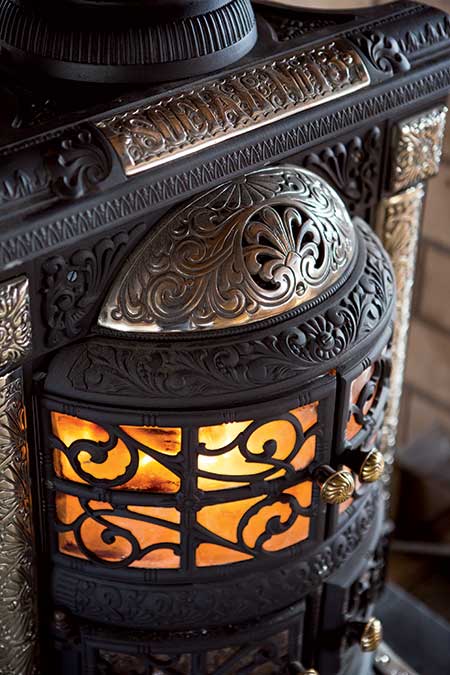Magazine
Antique Stove Hospital | Meet the Stove Doctors
In a crowded workshop in Little Compton, Rhode Island, a father and son give new life to old stoves that once breathed warmth and fire.

This beautiful antique stove, a “Social No. 13” made by Boston’s S. M. Howes Company, warms restorer Emery Pineo’s kitchen.
Photo Credit : Joel LainoIf you want to understand the history of heating in New England, the best place to begin is in the weeds behind Emery Pineo’s home in Little Compton, Rhode Island. That’s because Pineo’s expansive backyard is where many of the region’s remaining antique woodstoves go to die—or, if they’re among the lucky, to be reborn at the hands of the 69-year-old proprietor of the Antique Stove Hospital.
I first met Pineo, a self-proclaimed “paleostoveologist” (don’t bother looking it up—it’s not in the dictionary) more than five years ago, when my wife and I purchased a restored Glenwood cookstove for the kitchen of our Vermont home. We were the type of customer Pineo likes best, because we weren’t looking for a cleverly retro liquor cabinet or vintage conversation piece. Nope, we were actually going to cook on the thing. “We don’t get hoity-toity people in here very often,” Pineo told me, as he sat behind a sprawling antique desk. His small, tidy showroom is attached to the decidedly not-small and not-particularly-tidy workshop where he and his son Brandon resuscitate stoves, some of which have celebrated their 200th birthdays. “I’ll sell a stove to anybody with the money,” Pineo says, “but all things being equal, I’d rather sell it to be used.”
Emery Pineo’s entry into the field of paleostoveology began nearly four decades ago, when he restored his first specimen. “I grew up in the country, and one of my jobs as a kid was to go across the river to buy eggs from the Widow Lawrence,” he recalls. “She had a Glenwood C that she baked cookies in, and she always gave me cookies and a glass of milk. When she died, that stove got thrown away before she was in the ground.” He shakes his head, as if he still can’t fathom such crimes against stovemanity (don’t bother looking that one up, either).
The loss of the Widow Lawrence’s stove created in Pineo an itch that could be scratched by only one thing: antique-stove restoration. Soon he found himself with more work than he could handle. “Once word got out, I had people calling and dropping by with stoves every day,” he remembers. To date, he figures he’s restored thousands of stoves, although he lost track of the precise count long ago. These days he’s busier than ever, as concerns over the economy and the price of heating fuels compel his fellow New Englanders to reconsider wood heat. “As a culture, we seem to have forgotten how important woodstoves are,” he says. “It wasn’t that long ago that if you didn’t have a woodstove, you couldn’t survive.”
Indeed, woodstoves were once such a crucial and integral part of New England that practically every town had a foundry, and the number of different models available in the region approached 10,000. There were stoves set with handcrafted tiles, stoves with intricate etchings, and stoves that were held together solely by gravity, with nary a screw or bolt to be found. “The stove industry of 100 years ago was as big as the auto industry of today,” Pineo notes. “People come in all the time and ask, ‘Is this stove rare?’ And I have to say, ‘No, probably not.’”
Though most antique stoves aren’t rare, they do share a commonality that Pineo asserts is missing from modern wood heaters: quality. “Stoves today are too complicated, and they’re made of different materials that react to heat differently,” he explains. “People seem to have forgotten how to build a good stove. I figure that the best modern stoves are good for six or seven years. In 200 years, there aren’t going to be very many of them around.”
There’s another aspect to antique stoves that makes them compelling: affordability. Although the restored stoves the Pineos sell aren’t exactly cheap (full-size cookstoves start at about $1,600, and a complete restoration of a customer-owned stove runs from $1,400), they’re far more accessible than many pieces of antique furniture. And, as the world’s leading paleostoveologist is keen to remind us, an antique armoire isn’t going to keep you warm when the power goes out. Well, unless you burn it … which you really don’t want to do.
A black SUV pulls into the driveway, and Emery Pineo stops holding forth long enough to take a gander at the open maw of its cargo hold, which contains a gray-enamel Glenwood cookstove. Brandon ambles over, and the father-and-son team bend over the heater’s graceful curves, poking their heads into the firebox and the cavernous oven. “This is a brilliant stove,” Brandon says.
Emery nods his head: “This is a really, really nice stove.” He pauses and wipes his hands on his soot-stained flannel shirt. “Unless you want to sell it to me. Then it’s a piece of junk.”
Ben Hewitt
The Hewitt family runs Lazy Mill Living Arts, a school for practical skills of land and hand. Ben's most recent book is The Nourishing Homestead, published by Chelsea Green.
More by Ben Hewitt

